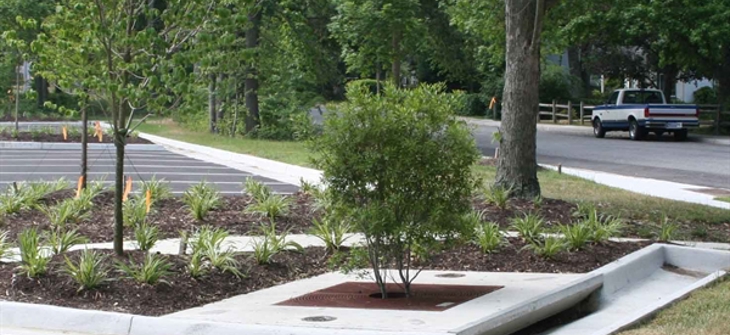
Leave the Bio in BioFilter...Plants Do Matter
Why Plants Matter: Enhancing Biofiltration with the Right Vegetation
Plants provide fresh oxygen to breathe and beautiful aesthetics that can take our breath away, but many people don’t think about the role plants can play in stormwater treatment. The principal notion of Low Impact Development (LID) is founded upon mimicking pre-development conditions. Part of mimicking pre-development conditions includes not just matching pre-development peak flow rates, but also matching the pollutant load discharging from the drainage area. What better way to follow LID principles to meet these pre-development loads than to imitate nature’s biological removal mechanisms in pre-development conditions. Biofilters (bioretention, constructed wetlands, bioswales, vegetated filter strips, etc…) are often specified to do just that. “Bio” implies that it is living organisms that are a component of the treatment process that work in concert with other pollutant removal mechanisms. Without plants as a critical component of the synergistic community of living organisms in these systems, biofilters are not as effective.
Plants are also key to sustainability in these systems and help to maintain an assimilative capacity over and above systems void of vegetation. Biofilters capture pollutants through various mechanisms, which are further broken down biologically by microorganisms into forms available for plant uptake via phytoremediation. As the plant grows and increases in biomass, so does the system’s capacity to capture and process more pollutants. Plants regenerate media pollutant removal capacity by making the media adsorption sites available for the next storm event.
Sustainability is not just defined by maintaining high pollutant removal, but also by maintaining design hydraulic flow rates over time. Plants help maintain hydraulic flow rate through their expanding root system. Roots shrink and swell during wetting and drying cycles keeping preferential pathways within the filtration media open. Plant roots continuously penetrate filter media as the plant grows, and the roots themselves die and regrow forming micro channels. This prevents media compaction and increases porosity, ultimately maintaining aeration and hydraulic rates. Plant roots and associated microbiological growth provide exudates which build and maintain soil structure. This increases macropore development for maintaining infiltration rates. At the surface, plant movement by wind or activity of birds, rodents, and insects which associate with the plants can increase hydraulic rates by breaking apart the sedimentation crust that occludes the surface. Plants also enhance volume reduction through evapotranspiration.
Most of the biological processes, for which biofilters are named, occur underground in the rhizosphere. The rhizosphere is the habitat where the plant root system interacts with the soil environment via root secretions and soil microorganisms. Millions of diverse microorganisms exist in the rhizosphere and exist to this magnitude only because of the plant. There are actually 10x more microorganisms in the rhizosphere than outside of it. But why are microorganisms important? Just as with plants in a natural, pre-development landscape, microorganisms degrade and transfer pollutants into less toxic forms through chelation for plant uptake, and sequestration of pollutants through carbon and nutrient assimilation. For example, microorganisms breakdown hydrocarbons, sequester metals into less toxic forms and sequester carbon for new cell material. Microorganisms alter the soil chemistry in the rhizosphere that enhances pollutant removal efficiency. Plants increase organic matter in the soil through decomposition of biomass, including the roots themselves, known as cell sloughing, which provides a carbon source to the microorganisms in the media. Additionally, mycorrhizae fungi create a symbiotic relationship with plant roots whereby plant roots excrete sugars for the fungi while the fungi provide “pollutants” to the plants in the form of nutrients for further biomass production. Mycorrhizae fungi increase the surface area of plant roots which ultimately enhances absorption of phosphorus, nitrogen, and metals which are all macro and micro plant nutrients that are vital for plant growth and reproduction.
This is a quick overview of the BIOLOGY in BIOfilter that is strongly supported by the existence of plants. So next time you’re planning stormwater treatment for a post development site and are considering a biofiltration practice, remember to mimic pre-development removal mechanisms and don’t forget the plants!
